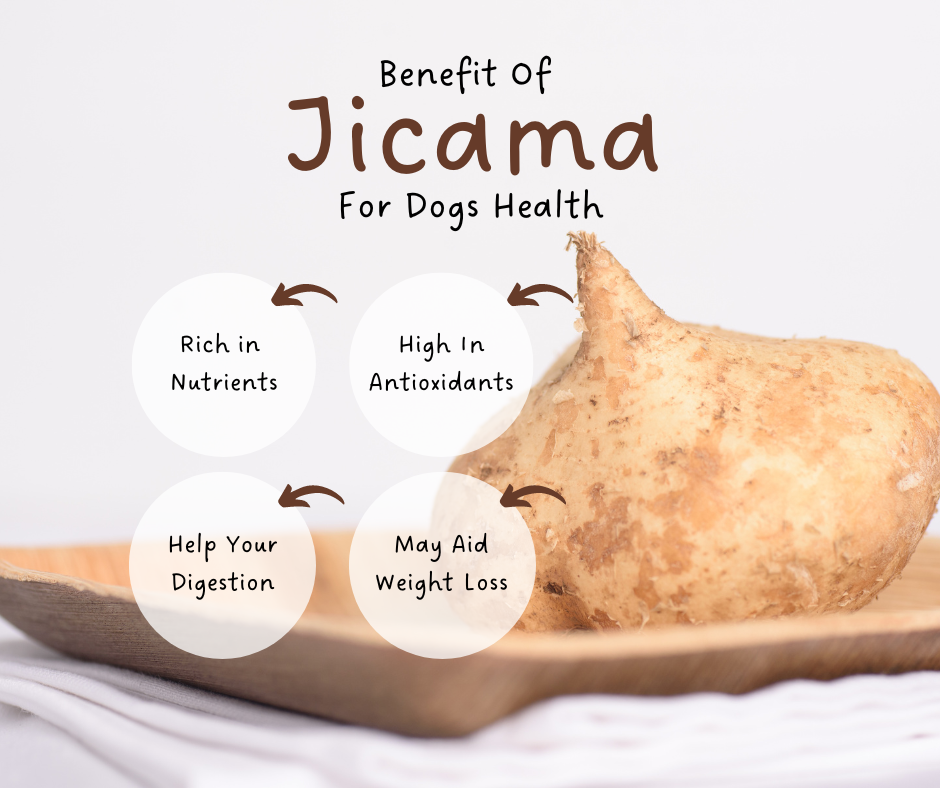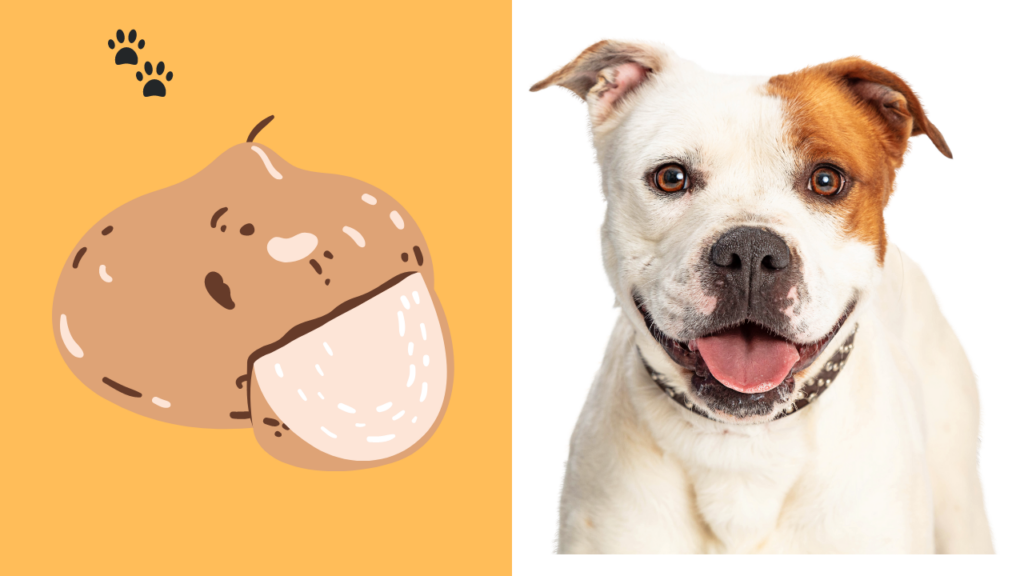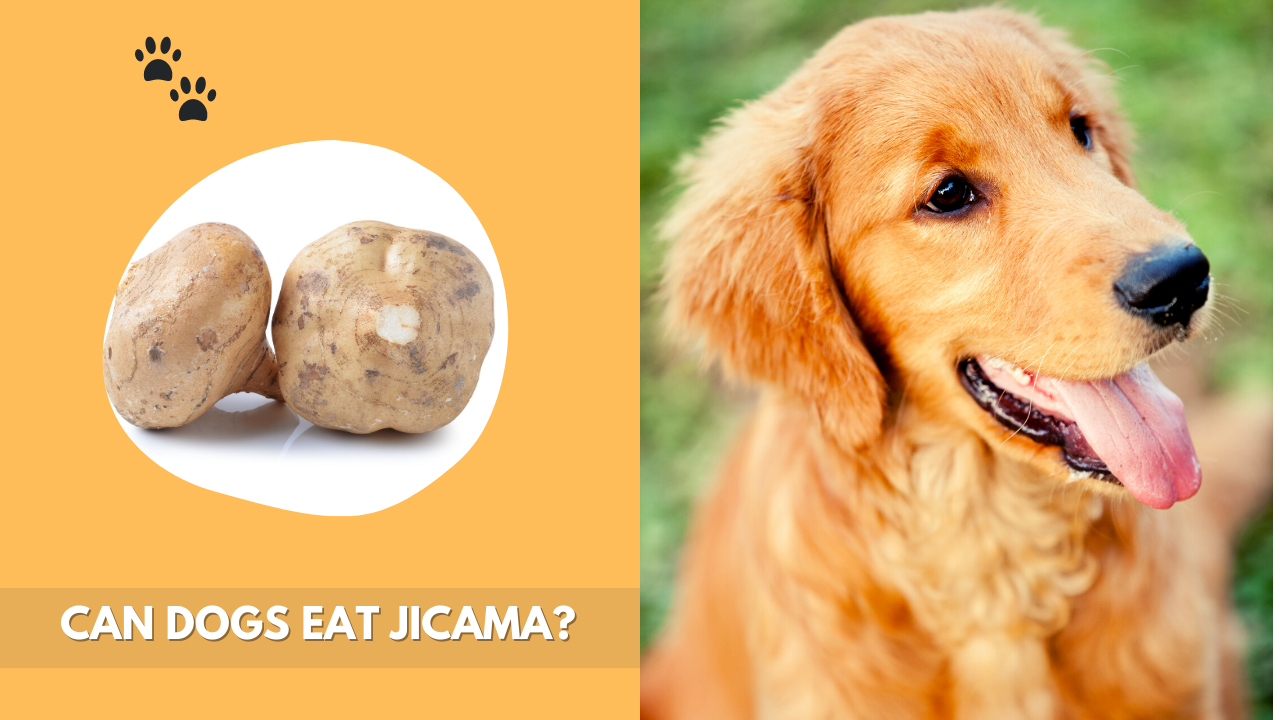You may have heard some conflicting information on can dogs eat jicama or cannot, so let’s take a closer look at this issue. In this blog post, I will uncover the surprising truth about canines eating jicama and explore its potential health benefits. So if you’re curious to find out if it is safe for your dog to indulge in a bit of jicama now and then, keep reading!
What is Jicama?
Jicama, sometimes known as the Mexican turnip, is a root vegetable that originates from Mexico. Its scientific name is Pachyrhizus erosus and it belongs to the pea family. It has an oblong shape and its exterior resembles a potato, with a light-brown rough skin. The flesh of the root is creamy white and crunchy, with a sweet flavor similar to that of an apple or pear.
Can dogs have jicama?
Have you wondered can dogs eat jicama sticks? Let me give you an answer. Yes, dogs can have jicama sticks. However, it’s important to only give them peeled jicama since other parts of the plant can be toxic. I recently gave my dog some jicama and she absolutely loved it! The crunchy texture and sweet taste were a hit with her – she definitely enjoyed the special treat. Just remember to always check with your vet before giving any new food or treat to your pup. Also, don’t forget to feed it in moderation!
Now you know can dogs eat fresh jicama? Jicama can be a great snack for your pup – just make sure to give it in small amounts.
Is jicama good for dogs? Nutritional benefits of jicama for dogs

Jicama is a great treat for dogs,due to its high nutritional value. Antioxidants, dietary fiber, vitamins, and minerals are abundant in it. It is also minimal in calories, fat, and sugar, making it a fantastic treat for dogs.
- When it comes to antioxidants, I’ve found that jicama is a great source. This vegetable contains powerful antioxidants that help protect your dog’s cells from damaging free radicals and reduce the risk of serious illnesses like cancer.
- Dietary fiber is an important part of any dog’s diet, and jicama provides plenty of it. The dietary fiber in this root vegetable helps support healthy digestion and aids in nutrient absorption for your pup.
- Jicama also provides vitamins and minerals to keep your pooch healthy! Together with other crucial elements like iron, magnesium, phosphorus, and more, it contains a lot of vitamin C. These nutritional benefits make it a great addition to any canine diet!
All in all, jicama is an excellent food source for your pup that provides a wide range of health benefits. Not only will it help keep them healthy, but your pup will love the sweet taste as well! So if you’re looking for a nutritious snack or side dish for your pup, try jicama!
What parts of the jicama are safe for dogs to eat?
You can feed your pup jicama but there are some parts of the jicama you should consider clearly before feeding them
Jicama is a delicious and nutritious root vegetable that I often enjoy feeding my pup. It has a unique flavor, like a cross between an apple and a potato. However, only parts of jicama are safe for dogs to eat. The flesh is edible, but the skin and leaves are toxic and should never be consumed. Therefore, if you plan to give jicama to your dog, make sure you peel it before feeding it to them.
Can dogs eat Jicama skin?
I recently discovered that jicama is actually safe for my pup to eat. I started feeding it to her in raw, peeled sticks, and she loves it! However, it’s important to note that the skin of a jicama can be toxic to dogs. So when feeding your pup jicama, make sure to only feed them peeled pieces.
Can dogs eat jicama leaves?
Jicama leaves are poisonous for dogs and can cause severe health complications. If your pet has ingested jicama leaves, it is important to seek immediate medical attention. Symptoms of jicama poisoning in dogs include vomiting, nausea, and even seizures. If left untreated, the toxicity of jicama leaves can be fatal to your pet. It is important to refrain from giving your pet jicama leaves or any other jicama plant parts in order to keep them safe.
Can dogs eat jicama seeds?
No, dogs should not eat jicama seeds. I have a dog and I learned that jicama seeds can be potentially dangerous for dogs. Jicama seeds can upset a dog’s stomach and make them throw up and have diarrhea. Moreover, rotenone is known to be harmful to animals, which may result in respiratory issues and even death. Therefore, it is important to avoid feeding jicama seeds, and considering clearly any other part of the plant, to your pet in order to keep them safe.
Can dogs eat jicama stem?
No, it’s definitely not a good idea to feed your dog jicama stem. I made this mistake before and found out the hard way that jicama stem can cause digestive upsets in dogs. The stem is also quite fibrous, which makes it difficult for a dog to digest and can cause irritation in their stomach. It’s recommended to stick with meals that are intended for canine consumption if you want to offer your dog a nutritious treat. There are plenty of healthy treats available that your pup will love!
Can dogs eat jicama sprouts?
No, the sprouts of a jicama plant are toxic to dogs and should not be fed to them. Stick to feeding your pup the peeled root of the jicama plant in order to provide them with the nutritional benefits of this food.
Potential risks of feeding jicama to dogs
I recently had a pet dog that loved to eat jicama. However, I soon realized that feeding jicama to my dog may not be the safest option. Though there are no strict warnings against feeding jicama to dogs, it may still cause problems if ingested in high quantities.
The main risks associated with feeding jicama to dogs are constipation, gastrointestinal problems, and even poisoning in extreme cases.
- Constipation is the most common issue related to feeding jicama to dogs. Jicama contains a high amount of fiber, which can cause indigestion, gas, and discomfort.
- Ingesting too much jicama can lead to gastrointestinal problems in dogs such as diarrhea, vomiting, and nausea.
- Due to its high quantities of oxalates, which can result in renal damage and other health problems, jicama can occasionally even be harmful to dogs.
Jicama should thus only be given to dogs sparingly, and owners should always seek the advice of a veterinarian before introducing any new foods to their dogs. As with any food, make sure to supervise your dog when eating jicama and ensure that they are not eating too much. Additionally, avoid feeding jicama to puppies or senior dogs as they may be more sensitive to its effects.
Preparation tips for feeding jicama to dogs
For a few months now, I’ve started giving my dogs jicama, and I’ve discovered it to be a wonderful supplement to their diet. Here are some tips to help you safely feed jicama to your dogs:
1. Make sure the jicama is fresh and without any mold or other signs of spoilage.
2. Peel the jicama and cut it into small pieces before feeding to your dog.
3. Add the pieces to your dog’s regular meal or give them as occasional treats.
4. If you plan to feed jicama regularly, keep an eye on your dog’s stool. Diarrhea can be a side effect of too much jicama in their diet.
5. Consult with your veterinarian before making any major changes to your dog’s diet. They can help you determine the correct amount and type of jicama to feed your pup.
By following these simple tips, you can safely incorporate jicama into your dog’s diet. Jicama is a delicious and nutritious vegetable that can provide your pup with vitamins, minerals, and fiber. Plus, they’ll love the taste! So go ahead and give your pup some jicama, just make sure you peel it first.
How much jicama a dog can eat?

As a pet parent, I have found that jicama can be a great source of essential vitamins and minerals for my pup. However, it is important to limit the amount of jicama that you feed your pup. I recommend no more than a quarter cup of jicama sticks at a time. Additionally, be sure to peel the jicama before you feed it to your pup, as some of the nutrients can be lost if the skin is left on. By following these simple guidelines, you can ensure that your pup will be able to enjoy jicama safely and healthily.
How long can jicama be stored?
Jicama can be stored for a while! I usually keep it in the fridge whole and unpeeled for up to two weeks. It may be peeled and kept for three days in an airtight jar with water before being consumed. You can also freeze jicama – simply peel and cut it as desired, then store in an airtight container for up to 6 months.
When it comes to canines and jicama, it can be given to your dog in small amounts as a treat. Be sure to remove the skin and cut into smaller pieces before feeding it to your pup. As with any new food, always check with your veterinarian before giving jicama to your dog.
What are some of the common signs that my dog isn’t enjoying jicama?
If your dog is not enjoying jicama, it may be a sign that they don’t like the taste or texture. Common signs that your dog isn’t enjoying jicama are:
- Refusing to eat it.
- Pacing or showing signs of anxious behavior after eating it.
- Vomiting or having diarrhea afterward.
- Showing signs of distress, such as drooling, panting, or shaking.
- Not wanting to be around the jicama after it has been fed to them.
- Avoiding contact with you, indicating they may be uncomfortable.
- Gagging or retching after eating it.
- Showing aggression towards the jicama or you when it is around.
- Not finishing their meal after being given jicama.
It is advised to stop giving your dog jicama if they start acting out in any of these ways and take them to the doctor for a checkup. The vet can help determine if your dog is having an adverse reaction to the food and provide treatment as needed.
Can senior dog have large amounts of Jicama due to its high fiber content?
Too much fiber in a dog’s diet can cause constipation, so I carefully monitored the amount of jicama I fed my senior pet. Generally, I recommend feeding your dog no more than a quarter cup of jicama per day to prevent digestive distress. Additionally, jicama contains inulin, a prebiotic which helps to foment healthy gut bacteria.
While this is beneficial in small doses, too much can cause bloating, gas, vomiting and diarrhea. If you’re not sure if your senior pet is intolerant to jicama or even allergic, it’s best to consult your veterinarian before introducing this food into their diet.
Ultimately, when feeding jicama to your senior pet, it’s important to ensure you’re mindful of the quantity and watch for any signs of adverse reactions so that your pet can enjoy a healthy, balanced diet.
What are some recipes to incorporate jicama into dog’s diet?
Jicama is a delicious and nutritious treat for your dog that can add texture and flavor to their diet. These are some straightforward recipes you may use to feed jicama to your dog:
1. Jicama and Apple Dog Treats
Jicama, applesauce, and cinnamon are blended together in a food processor with one cup of jicama. Blend until the mixture is well-combined. Place the mixture into an ice cube tray and freeze overnight. Pop out of the tray and serve your pup a frozen treat!
2. Jicama and Sweet Potato Dog Food
Jicama, sweet potato, and 1/4 teaspoon cinnamon are blended together with one cup of jicama. Blend until the mixture is well-combined. Serve your pup a portion of this flavorful dog food each day.
3. Jicama and Carrot Dog Snack
Jicama and carrots totaling 1/2 cup each should be cut into tiny pieces. Roast for 20 minutes at 350 degrees in the oven. Let cool and serve as a crunchy snack for your pup!
4. Jicama and Peanut Butter Dog Treats
Jicama and 1/4 cup of creamy peanut butter are mashed together in a bowl. Roll into small balls and place onto a parchment-lined baking sheet. Bake for 10 minutes at 350 degrees. Allow the treats to cool completely before serving to your pup!
These recipes are a great way to give your pup the taste and nutrition of jicama. See which dish your dog prefers by trying one or all of them!
FAQs
Are there any other vegetables that are similar to jicama that I can offer my dog?
Yes, there are several vegetables that are similar to jicama and safe for dogs. These include turnips, carrots, and sweet potatoes.
Are there any fruits that are safe for my dog to eat with jicama?
Yes, there are several fruits that are safe for dogs to eat in combination with jicama. For examples: strawberries, bananas, pears, apples, and pears. Each of these fruits have such a low sugar content and are rich in vitamins that are good for your dog’s health.
Is jicama a good snack for dogs between meals?
Yes, jicama can be a great snack for dogs between meals. Its high vitamin, mineral, and fiber content together with low calorie count will help keep your dog feeling full and energized in between meals.
Is jicama safe for dogs with allergies or sensitivities?
It is always a good idea to check with your veterinarian before you want to feed jicama to your pup with allergies or sensitivities
Are there any other animals that can eat jicama?
Jicama can be a great snack for rabbits, guinea pigs, horses, and other animals as well. These animals will benefit from the vitamins and minerals that are found in jicama.
Conclusion
In summary, can dogs eat jicama? Yes, with caution. Jicama can be a great source of vitamins and minerals for your pup if fed in moderation. It’s crucial to keep in mind, though, that consuming too much jicama might result in constipation, gastrointestinal issues, or even poisoning in extreme circumstances. Always consult with a veterinarian before making any changes to your dog’s diet and make sure you peel the jicama before feeding it to them. By keeping in mind these few suggestions, you can guarantee that your dog will remain healthy and enjoy this delectable treat!

